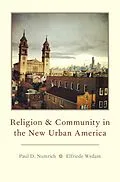Religion and Community in the New Urban America examines the interrelated transformations of cities and urban congregations. The authors ask how the new metropolis affects local religious communities and what role those communities play in creating the new metropolis. Through an in-depth study of fifteen Chicago congregations-Catholic parishes, Protestant churches, Jewish synagogues, Muslim mosques, and a Hindu temple, both city and suburban-this book describes congregational life and measures congregational influences on urban environments. Paul D. Numrich and Elfriede Wedam challenge the view held by many urban studies scholars that religion plays a small role-if any-in shaping postindustrial cities and that religious communities merely adapt to urban structures in a passive fashion. Taking into account the spatial distribution of constituents, internal traits, and external actions, each congregation's urban impact is plotted on a continuum of weak, to moderate, to strong, thus providing a nuanced understanding of the significance of religion in the contemporary urban context. Presenting a thoughtful analysis that includes maps of each congregation in its social-geographic setting, the authors offer an insightful look into urban community life today, from congregations to the places in which they are embedded.
Autorentext
Paul D. Numrich is a professor at Methodist Theological School in Ohio and Trinity Lutheran Seminary, and an affiliate research associate with the McNamara Center for the Social Study of Religion at Loyola University Chicago. He researches the social, civic, and theological implications of America's increasing religious diversity. Elfriede Wedam is lecturer in the department of sociology and research associate with the McNamara Center for the Social Study of Religion at Loyola University Chicago. She has written on urban religion, community, the moral culture of the prolife movement and Catholic parishes in an international context.
Zusammenfassung
Religion and Community in the New Urban America examines the interrelated transformations of cities and urban congregations. The authors ask how the new metropolis affects local religious communities and what role those communities play in creating the new metropolis. Through an in-depth study of fifteen Chicago congregations-Catholic parishes, Protestant churches, Jewish synagogues, Muslim mosques, and a Hindu temple, both city and suburban-this book describes congregational life and measures congregational influences on urban environments. Paul D. Numrich and Elfriede Wedam challenge the view held by many urban studies scholars that religion plays a small role-if any-in shaping postindustrial cities and that religious communities merely adapt to urban structures in a passive fashion. Taking into account the spatial distribution of constituents, internal traits, and external actions, each congregation's urban impact is plotted on a continuum of weak, to moderate, to strong, thus providing a nuanced understanding of the significance of religion in the contemporary urban context. Presenting a thoughtful analysis that includes maps of each congregation in its social-geographic setting, the authors offer an insightful look into urban community life today, from congregations to the places in which they are embedded.
Inhalt
Foreword by Martin D. Stringer Preface and Acknowledgements Introduction: The New Urban Era and the Religion Factor Part I: Theoretical and Conceptual Framework Chapter 1: Adding Religion to Chicago's Story Chapter 2: Community and Congregations in the New Metropolis Part II: Congregational Case Studies Chapter 3: Neighborhood Parishes and Churches in a Restructuring City Chapter 4: Area Mosques and Diverse Corridors Chapter 5: Area Congregations in the City Chapter 6: Area Congregations in a Suburban Boom Town Chapter 7: Metro Congregations: A Wider View of the Restructuring Metropolis Part III: Religion's Urban Significance: Chicago and Beyond Chapter 8: Congregations and Change: Interpreting Religion's Significance in the New Metropolis Afterword: A Case for Representativeness Appendix A: Research Methods Appendix B: Questionnaire Appendix C: Field Notes on Worship Services Appendix D: Protocol for In-Depth Study of Religious Congregations Bibliography Index
